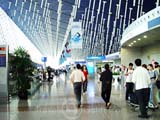Shanghai TransportationShanghai has an extensive public transportation system, largely based on buses, and a rapidly expanding metro system. For a city of Shanghai's size, road traffic is still fairly smooth and convenient but getting more congested as the number of cars increases rapidly. If visitors will be staying in Shanghai for a long time, it would be convenient to get a Shanghai Transportation Card, or Shanghai Jiaotong Card. The card costs RMB 100, including RMB 30 for deposit and RMB 70 for use. It can be used not only on subway, but some public buses, ferries and even taxis. Travelers can get these cards at any metro/subway station, as well as some convenience stores.
Shanghai has two international airports:
Pudong International Airport
Hongqiao International Airport Located in the west of Shanghai, Hongqiao International Airport is only 13 kilometers (8 miles) from the city center. It mainly handles domestic flights. From Hongqiao International Airport to the city center, seven bus lines provide regular services. For more information, inquiries can be made by telephone to the airport at (8621) 5260-4620. Notice To Air Travelers Travelers should check which airport their flight is leaving from, and arrive at least 1.5 hour to 2 hours before departure. Domestic airplane tickets should be booked at least two days in advance at one of the many travel agencies. Fares are generally cheap, but vary depending on the season. When backpacking, it may often be better to book a flight along a big traffic line (Beijing-Shanghai, Beijing-Chongqing, shanghai-Shenzhen) and travel the rest by bus or train.
Shanghai has three train stations that provide convenient transportation for tourists. Train tickets are also most conveniently booked at least one day in advance through travel agencies or directly at the three stations. Shanghai Railway Station ( 上海站 ) The Shanghai Railway Station is Shanghai's largest and oldest train station. It is located in Zhabei district on the intersection of Metro Lines 1, 3 and 4. Travelers can access many different destinations though this train station, including trains to Hong Kong. Everyday 70 or so trains run between other cities all over the country. A train journey to Suzhou takes between 40 and 90 minutes. Ticket Office Address: Underground of the Complex Ticket Office of the Railway Station Shanghai South Railway Station ( 上海南站 ) The Shanghai South Railway Station is a new, greatly expanded terminal which was completed in July 2006. It is set to take over all services towards the south. It is located in the Metro lines 1 and 3. Ticket Office Address: No. 289 Old Humin Road, Shanghai The Shanghai West Railway Station is the smallest of the three stations, with limited services to Yantai, Zaozhuang, Hengyang, Ganzhou and Chengdu. It is not reachable by metro. Ticket Office Address: No. 22 Taopu Road, Shanghai Trains from Shanghai to Beijing
Shanghai Port is the largest one in Mainland China, covering an area of 3,600 square kilometers. Since 1980s, Shanghai Port has become a world-class port with a handling capacity of 100 million tons. In terms of ocean going lines, you can reach various destinations including Hong Kong, Japan, Southeast Asia, Australia, Israel, Mediterranean, Northwest Europe, South Africa, South America and East and West Coasts of USA. In terms of coastal lines, you can reach the major harbors along the coast from north to south, and in terms of the Yangtze River lines you can directly reach the ports along the mid and lower reaches of Yangtze River. Through the inland water transportation, you can reach all the ports and harbors of Jiangsu, Zhejiang and Anhui Provinces via the waterway network in the south of Yangtze River Basin.
Sightseeing Bus Shanghai Sightseeing Bus Center is a self-aid Tourist Center specially set up by Shanghai Municipal Tourism Administrative Commission for the convenience of making tours for individual Chinese and foreign tourists. It was listed as one of Shanghai Government's Planned Projects in 1998. The Center mainly offers self-aid tours and supplies different
kinds of package tour tickets. The package tickets include the
bus tickets back and forth from the center and entrance tickets
to tourist scenic spots. It can also arrange accommodation for
tourists in some tourist areas. The center provides guides on
the buses to introduce the scenic spots to tourists. One of the oldest travel lines operating in Shanghai is the Jinjiang Sightseeing Bus, whose route connects some famous sights in the downtown area, like People Square, Oriental Pearl TV Tower, Yuyuan Garden, and the Bund. There are also sightseeing buses on Nanjing Road that takes tourists through the bustling Nanjing Road Pedestrian Street. Public Bus
The Shanghai Metro (上海轨道交通) is an urban rapid transit system that serves the city of Shanghai by transporting around 1.8 million passengers each day. The system incorporates both subways and elevated light railways, and has five lines (numbers 1, 2, 3, 4, 5) at present, with four more new lines under construction, along with extensions to the lines currently in operation. As new metro lines are opened, passenger volumes are expected to rise significantly. Shanghai is the third city in China to build a subway system after Beijing and Tianjin and currently operates more lines than any other subway system in mainland China. The Shanghai Metro is considered the fastest and most convenient way of getting around Shanghai. Main attractions and bustling commercial areas such as the Bund, Longhua Temple, Nanjing Road, Huaihai Road and Xujiahui are linked by two subway lines, Subway Line 1 & 2, and the light rail Pearl Line (Mingzhu Line). Fares range from RMB 2 to RMB 8 depending on distance. If travelers do not have the transportation card, be sure to bring plenty of small change such as RMB 0.5 or RMB 1 for the ticket vending machines, although most stations also have staff selling tickets.
Taxis in Shanghai are plentiful and market competition has driven taxi fare down to affordable prices for the average resident. Taxi is generally a good choice for transportation in the city as it saves a lot of time. But try to get your destination written down in Chinese characters prior to getting in the cab as communication can be an issue. Taxi colors in Shanghai are strictly controlled and indicate the company the taxi belongs to. Dazhong Taxi Company operates sky blue taxis, Qiangsheng - orange, Jinjiang - white, Bashi - green and Nonggongshang - blue. Of all the taxi companies, Dazhong and Qiangsheng are the best. It would also be important to know that Taxis in Shanghai have stars displayed below the driver's photograph on the dashboard in front of the passenger seat. The amount of stars indicates the length of time the driver has been in the taxi business and the level of positive feedback received from customers. The number of stars range from zero to five. Drivers with one star or more should know all major locations in Shanghai, and those with three stars should be able to recognize even lesser-known addresses. Remember that it takes time to build up these stars; so riders shouldn't panic if they find themselves with a driver who doesn't have any - just have them confirm that they know where they are going and one should be fine. Be sure to use the taxi meter and it would be better to have a printed receipt before paying. In the daytime, the price is RMB 11 for the first 3 kilometers (1.9 miles), an additional charge of RMB 2.1 for every succeeding kilometer within 10 kilometers, and about RMB 3.15 for every succeeding kilometer after 10 kilometers (6.2 miles). At night from 11:00pm to 5:00am, the price of a taxi is about RMB 14 for the first three kilometers, an additional charge of about RMB 2.73 for every succeeding kilometer within 10 kilometers and an additional about RMB 3.36 for every succeeding kilometer after 10 kilometers. Passengers can bargain over prices when taking taxis at night. Complaints about unreasonable night prices or other complaints can be filed by calling (8621) 6323-2150. The complaint telephone number can be found on the taxi's stuck to the interior panels of the car. For taxi booking, please call the following taxi companies:
Before the 1990s, bicycling was the most ubiquitous form of transportation in Shanghai, but the city has since banned bicycles on many of the city's main roads to ease congestion. However, many streets have bicycle lanes and intersections are monitored by "Traffic Assistants" who help provide for safe crossing. Most hotels have bicycles for rental. It costs around RMB 15-30
per day. Bicycle deposits can be made either by paying RMB 200-400,
or using a passport. Bicycles can also be purchased. New bicycles
can cost anyway between RMB 150 – 500; and second hand bicycles
can be purchased from RMB 80 – 150. |

 Situated on the south bank of the Yangtze River estuary in east
Shanghai, Pudong International Airport, completed in 1999, is
about 30 kilometers (19 miles) away from the city center and
40 kilometers (25 miles) from Hongqiao International Airport.
In total, about fifty airlines have flights to over sixty domestic
cities and over seventy cities to other countries and regions.
For more information, contact the airport number at (8621) 9608-1388.
Situated on the south bank of the Yangtze River estuary in east
Shanghai, Pudong International Airport, completed in 1999, is
about 30 kilometers (19 miles) away from the city center and
40 kilometers (25 miles) from Hongqiao International Airport.
In total, about fifty airlines have flights to over sixty domestic
cities and over seventy cities to other countries and regions.
For more information, contact the airport number at (8621) 9608-1388. Shanghai
has the world's most extensive bus system with nearly one thousand
bus lines.
Shanghai
has the world's most extensive bus system with nearly one thousand
bus lines.
